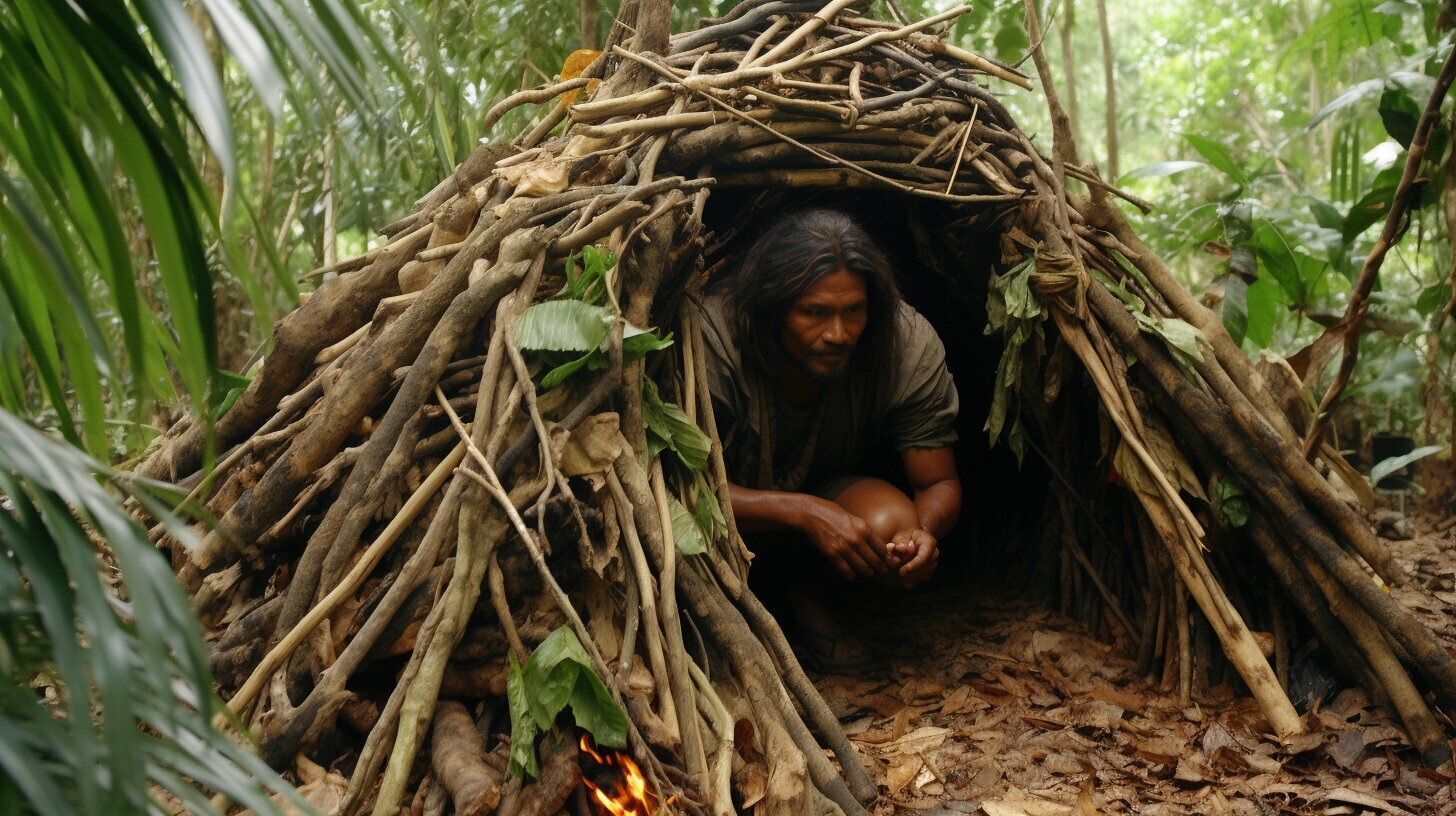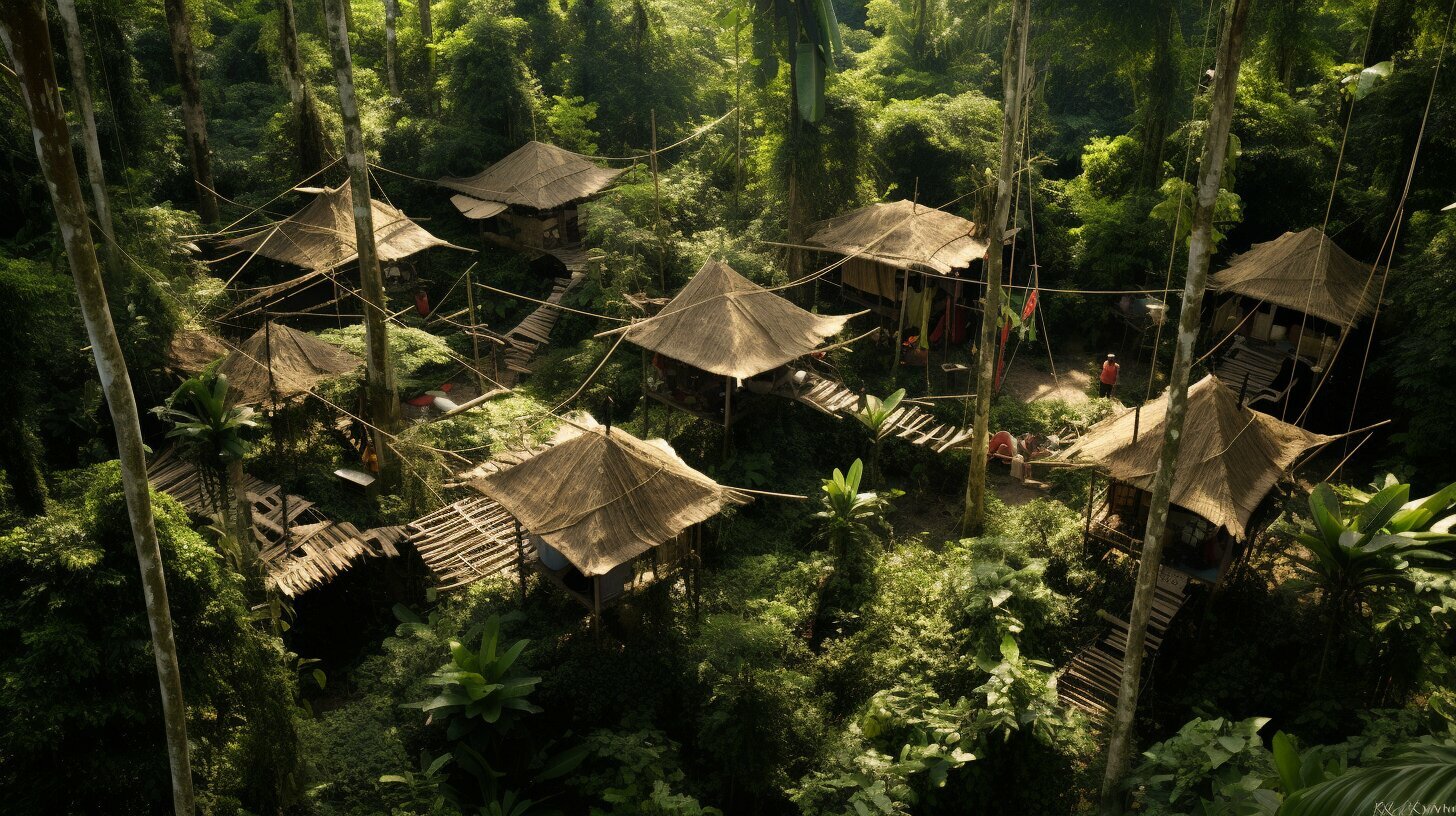Are you planning a jungle adventure? Or do you simply want to be prepared in case of an emergency? Whatever your reason may be, it’s crucial to have essential jungle survival skills and tips to ensure your safety in the wilderness.
The jungle can be a beautiful but dangerous place. With unpredictable weather, difficult terrain, and potentially harmful wildlife, proper preparation and knowledge can make all the difference. By learning and mastering jungle survival skills, you’ll be equipped to handle any challenges that may arise.
Disclosure: When you buy through links on our site, we may earn an affiliate commission.
Key Takeaways
- Having essential jungle survival skills and tips is crucial for your safety in the wilderness.
- The jungle can present unpredictable weather, dangerous terrain, and potentially harmful wildlife.
- Mastering jungle survival skills will equip you to handle any challenges that may arise.
Understanding the Tropical Wilderness
Surviving in the tropical wilderness requires a specific set of jungle survival techniques. The dense foliage, extreme weather conditions, and dangerous wildlife demand a high level of preparedness and skill.
To master tropical wilderness survival, you must first understand the unique challenges and characteristics of this environment. The following are some key factors to consider:
Climate
The tropical climate is hot and humid, with frequent rainfall and high humidity levels. You must be prepared for sudden changes in weather, such as thunderstorms and high winds.
Vegetation
The dense vegetation in the tropical wilderness can make navigation and movement challenging. You must be able to identify different plant species, including poisonous ones, and know which ones are safe to use for food and shelter.
Wildlife
The tropical wilderness is home to a diverse range of wildlife, including snakes, insects, and large predators such as jaguars. You must know how to avoid dangerous animals and defend yourself when necessary.
To navigate the tropical wilderness and stay safe, you must have a solid understanding of these factors and be equipped with the necessary jungle survival techniques. These techniques include:
Navigation
Using natural landmarks such as the sun and stars, as well as basic orienteering skills, can help you maintain a sense of direction in the jungle.
Shelter Building
Building a sturdy and secure shelter is essential for protection from the elements and wildlife. Knowing the best materials and techniques for constructing a shelter in the jungle can make all the difference.
Fire Starting
A fire provides warmth, light, and a means of cooking food in the jungle. Knowing how to start a fire using natural materials can be a lifesaver in a survival situation.
Water Sourcing
Knowing how to locate and purify water sources in the jungle is essential for survival. You must be able to identify safe sources of water and know how to make it safe for consumption.
Understanding the challenges and unique characteristics of the tropical wilderness is the first step in mastering jungle survival techniques. By training in these essential skills and techniques, you can increase your chances of survival in this demanding environment.
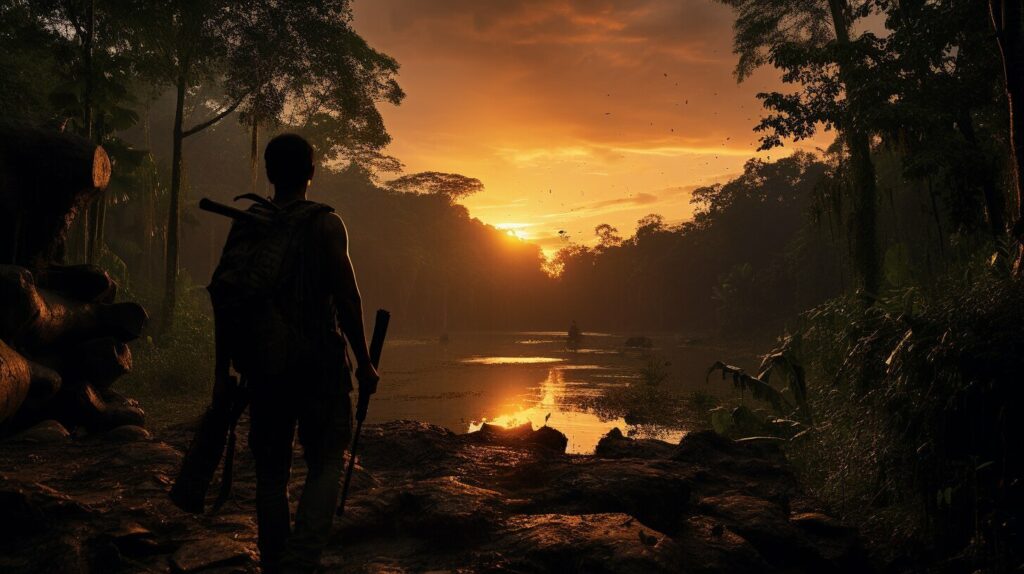
Assessing the Jungle Environment
When it comes to jungle survival, assessing your environment is critical. By understanding the potential hazards and challenges of the jungle, you can develop effective outdoor survival tactics and jungle survival tips to keep yourself safe and secure.
Weather
The weather can be unpredictable in the jungle, and sudden downpours or temperature drops can have a significant impact on your well-being. To stay safe, make sure you pack appropriate clothing, including rain gear and layers for warmth. Keep an eye on the sky, and if you notice any signs of an impending storm, seek shelter immediately.
Wildlife
The jungle is home to various dangerous animals that pose a threat to human safety, such as snakes, spiders, and large predators like jaguars. Before you venture into the jungle, research the wildlife in the area and learn how to avoid encounters or defend yourself in case of an attack. Some outdoor survival tactics include carrying bear spray and a knife or practicing noise discipline to avoid startling animals.
Terrain
The terrain in the jungle can be challenging to navigate, with dense vegetation and uneven ground. When assessing your environment, pay attention to the terrain features of the area, such as hills or rivers, that can impact your movements. Make sure you wear sturdy shoes or boots with good traction to prevent slips or falls.
Table: How to Assess the Jungle Environment
| Factor | Jungle Survival Tips | Outdoor Survival Tactics |
|---|---|---|
| Weather | Pack appropriate clothing including rain gear and layers for warmth | Listen to weather reports and seek shelter immediately in case of storms |
| Wildlife | Research the wildlife in the area ahead of time, learn how to avoid encounters or defend yourself in case of an attack | Carry bear spray and a knife, practice noise discipline to avoid startling animals |
| Terrain | Pay attention to the terrain features of the area, wear sturdy shoes or boots with good traction to prevent slips or falls | Use a walking stick for stability, scout the area ahead of time to avoid difficult terrain features |
Assessing the jungle environment is the first step towards effective jungle survival. By taking into account factors such as weather, wildlife, and terrain, you can make informed decisions and take appropriate action to stay safe. Remember to pack appropriate gear, do your research, and always stay alert and aware of your surroundings.
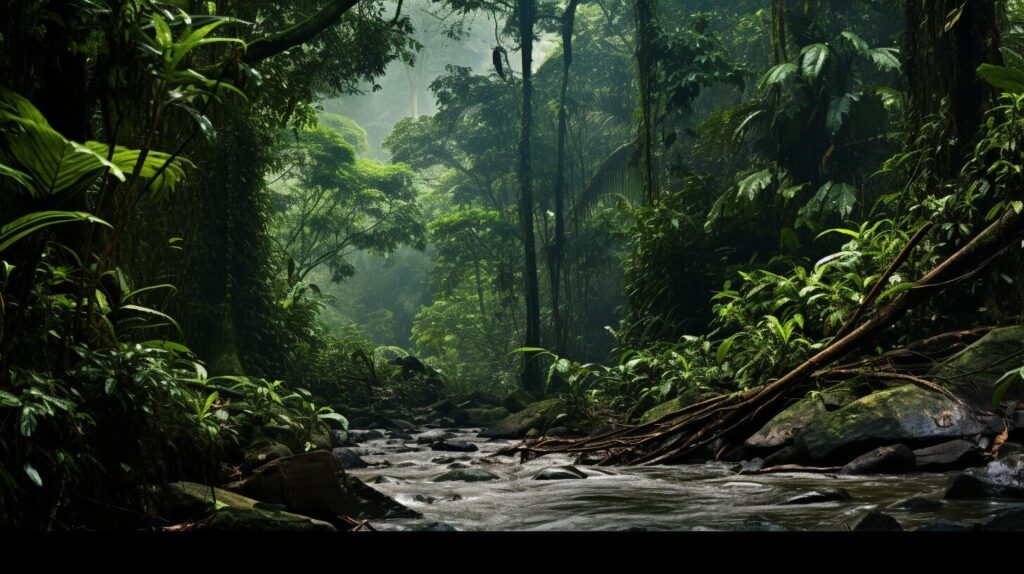
Building a Jungle Shelter
When stranded in the jungle, building a sturdy shelter should be your top priority. A shelter will provide you with a safe place to rest and protect you from the elements. It can also help you maintain a positive mindset and increase your chances of survival. Here are some jungle survival techniques to consider when building a shelter:
Gather Materials
Before starting your shelter, gather materials from the surrounding area. Look for sturdy branches, leaves, and vines that can support your structure. If possible, try to find a location that offers natural protection, such as a cave or rock formation.
Build a Frame
Once you have your materials, begin building your frame. Start by creating a framework using strong branches or poles. Lean them against each other to form a triangle or A-shape structure. Make sure the frame is sturdy enough to support your weight and any additional materials.
Add Coverings
After building the framework, add coverings to your shelter. Use large leaves or branches to create a roof, and weave vines through them to hold them in place. Make sure your shelter is fully covered to protect you from rain and wind. You can also use branches or other materials to create walls for added protection.
Create a Bed
Finally, create a bed inside your shelter. Lay down large leaves or other soft materials to create a comfortable surface. This will help you get a good night’s sleep and make your stay in the jungle more bearable.
Remember, building a shelter is just one of the essential jungle survival techniques you need to master. By learning these skills and being prepared for the wilderness, you can increase your chances of survival and make the most of your jungle adventure.

Finding and Purifying Water
When it comes to jungle survival tips, finding and purifying water is essential. Without access to clean water, dehydration can quickly become a major problem, putting your survival at risk.
When searching for water in the jungle, there are a few things to keep in mind. Remember that moving water is often a safer choice than still water, which can contain harmful bacteria and parasites. Look for areas where water is flowing, such as near a stream or at the bottom of a waterfall.
If you are unable to find moving water, you may need to collect still water and purify it for safe consumption. There are several ways to do this, including boiling, chemical treatment, and filtration.
- Boiling: Boiling water is the most effective way to kill harmful bacteria and parasites. Simply bring water to a rolling boil for at least one minute to ensure it is safe to drink.
- Chemical Treatment: Chemical water treatment tablets are an effective way to purify water in the jungle. Follow the manufacturer’s instructions carefully for best results.
- Filtration: A portable water filter can be a handy tool for purifying water in the jungle. Look for a filter that removes bacteria, parasites, and other harmful contaminants.
Remember to always prioritize finding a source of water as soon as possible in a survival situation. It’s also a good idea to carry a water bottle or canteen with you at all times, so you can collect and transport water as needed.
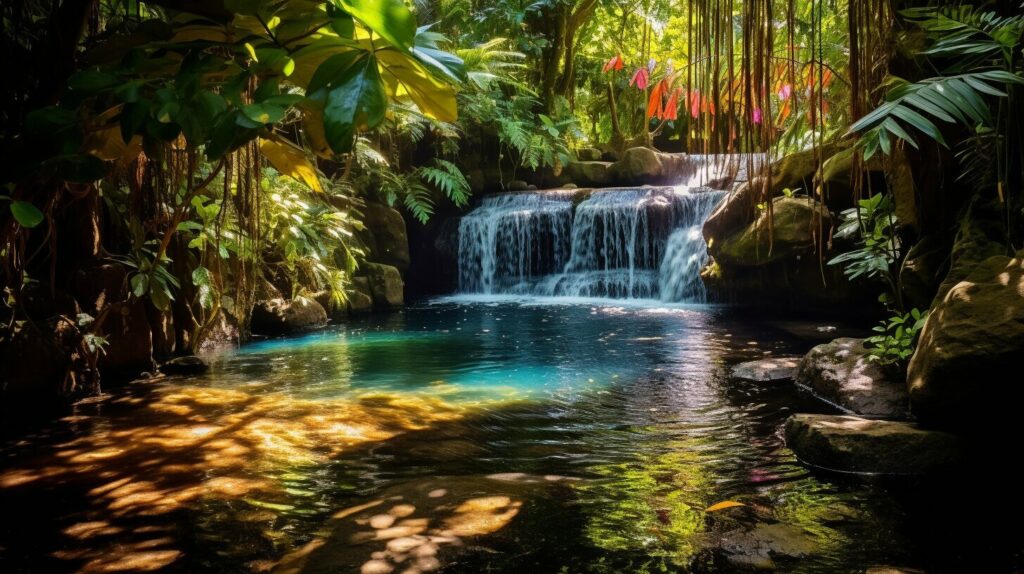
Mastering Fire Skills
When you find yourself in a jungle survival situation, fire can be a crucial factor for your survival. Not only does it provide warmth and security, but it also allows you to cook food and purify water. Therefore, mastering fire skills is essential.
Here are some fire-starting techniques:
- Bow drill: This method involves using a spindle and a bow to create friction and generate a coal that can ignite a fire. It requires practice and patience but can be effective in the jungle.
- Flint and steel: These fire-starting tools can be a reliable backup option. Strike the flint against the steel to create sparks that can ignite dry tinder.
- Sunlight: Use a magnifying glass or convex lens to focus sunlight onto a dry leaf or piece of paper, which can then be used to ignite a fire.
In addition to these techniques, it’s important to gather dry tinder and kindling beforehand to ensure you have ample resources to start and maintain a fire. Look for dry leaves, grass, and twigs, and organize them by size and shape, so you can easily access them when needed.
What to Consider When Building a Fire
When building a fire in the jungle, there are some important things to keep in mind. Firstly, be aware of your surroundings and make sure you have enough space to build a fire safely. Secondly, consider the wind direction and avoid placing your fire downwind from your shelter or water source, to prevent the fire from spreading or smoke blowing in your direction.
Always keep a careful eye on your fire and never leave it unattended. When you’re ready to extinguish the fire, spread the ashes over a wide area, making sure they are fully extinguished. Pour water over the fire and stir it with a stick to ensure there are no burning embers left.
Remember, fire can be a lifesaver, but it can also be dangerous. So, always approach it with caution and respect, and be prepared with the right survival skills and outdoor survival tactics.
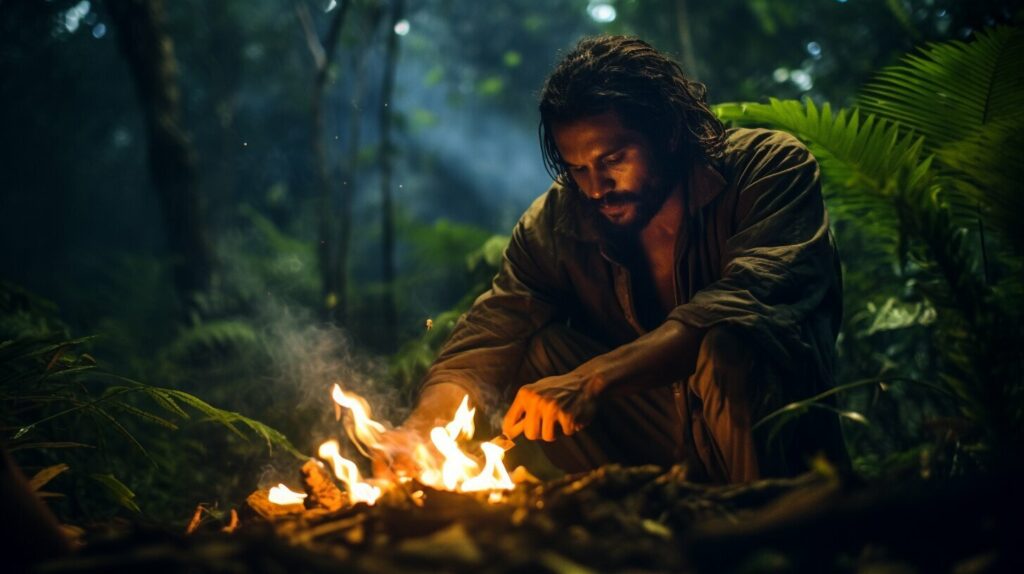
Navigating in the Jungle
Navigating in the jungle requires a set of specialized skills. Failure to navigate properly can lead to getting lost or ending up in dangerous areas. To avoid such pitfalls, keep the following tips in mind:
- Stay oriented: Before leaving, make sure you know the direction of your starting point. Use a compass or landmark to help you keep your bearings.
- Use natural landmarks: Jungle terrains can be tough to navigate, but natural landmarks such as rivers, mountains, or large trees can serve as guides. Use them to help you remember your path and make your way back.
- Learn basic orienteering: Basic orienteering skills such as map reading and calculating distances can be useful in navigating unfamiliar terrain. Use them to gauge your route and plan your journey.
It’s important to remember that jungle navigation can be challenging even for experienced adventurers. Be patient, stay alert, and don’t be afraid to ask for help if you feel lost.
The Importance of Staying Hydrated
In the jungle, staying hydrated is essential for survival. Dehydration can lead to weakness, confusion, and a host of other problems that can put your safety at risk. Here are some tips for finding and purifying water:
- Look for water sources: Keep an eye out for streams, rivers, and other bodies of water. They’re often the most reliable sources for drinking water.
- Purify your water: Boiling, filtering, and using chemical treatments are all effective ways to purify water. Boiling is the most reliable method, as it kills most bacteria and viruses.
- Stay ahead of dehydration: Don’t wait until you’re thirsty to start drinking water. Drink regularly throughout the day to keep your body hydrated.
Remember, drinking contaminated water can lead to serious illness. Take the time to purify your water by using one or more of the above techniques.
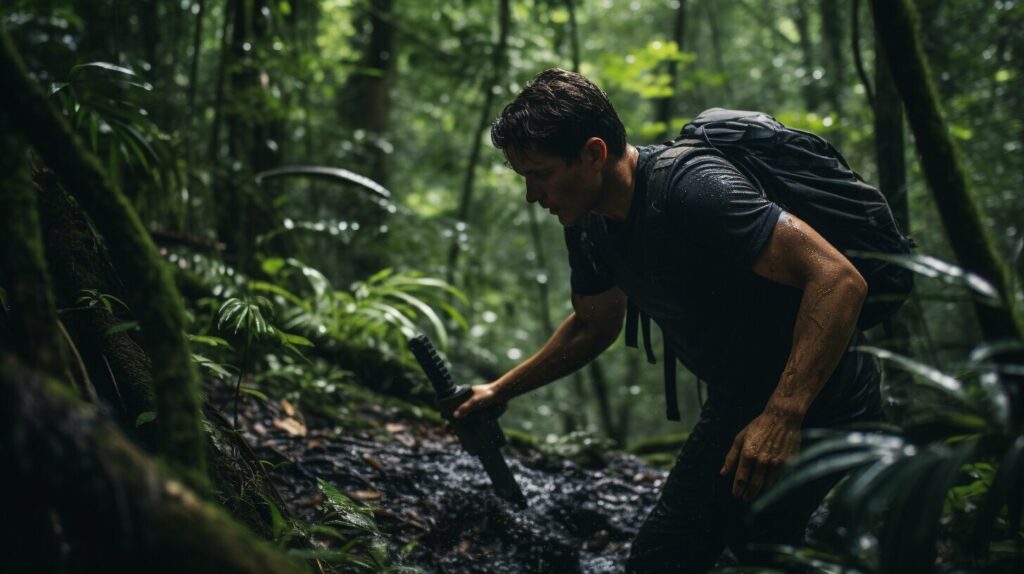
Obtaining Food in the Jungle
Food is crucial for survival in the jungle. It provides energy to keep you going and keeps your morale up. Knowing how to obtain food in the jungle is an essential survival skill. There are various ways to get food in the jungle, including hunting, fishing, and gathering wild edible plants.
Hunting
One of the most effective ways to get food is through hunting. You can hunt for animals such as monkeys, deer, and wild boars. However, you should be aware of the hunting laws in the area you are in. Hunting laws vary by location, and some animals may be protected.
It’s important to use the right tools for hunting in the jungle. A machete can work well as a hunting and skinning tool. A slingshot or bow and arrow can be useful for hunting small game.
Fishing
Fishing is another option for obtaining food in the jungle. Rivers and streams in the jungle can be full of fish, but you need to know how to catch them. One way to catch fish is by using a spear or a fishing net. You can also use bait and a fishing line to catch fish.
It’s important to be aware of potential dangers when fishing in the jungle. Some fish may be poisonous, so it’s crucial to know which fish are safe to eat. You should also watch out for other predators in the water, such as crocodiles.
Gathering Wild Edible Plants
Another way to get food in the jungle is by gathering wild edible plants. There are several varieties of plants that are safe to eat, including fruits, leaves, and roots. However, it’s crucial to know which plants are safe to eat and which ones are poisonous.
You should also be careful not to damage the ecosystem of the jungle when gathering plants. Only take what you need and avoid taking from areas where the plants are scarce.
| Edible Plants in the Jungle | Location |
|---|---|
| Bananas | Grows on trees throughout the jungle |
| Papaya | Grows on trees throughout the jungle |
| Taro | Grows in swampy areas |
| Bamboo Shoots | Found near bamboo plants |
| Coconut | Grows on palm trees in coastal areas |
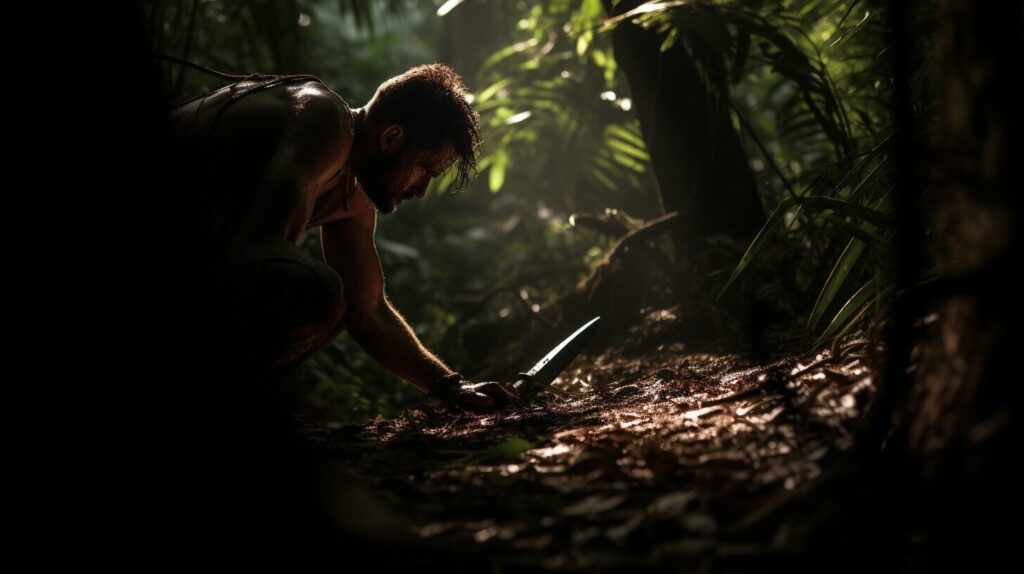
Obtaining food in the jungle can be a challenge, but with the right skills and knowledge, you can survive. Remember to be aware of the laws and regulations in the area you are in and always prioritize safety. By hunting, fishing, and gathering wild edible plants, you increase your chances of survival in the jungle.
Jungle First Aid
When you are lost in the jungle, accidents can happen unexpectedly. Knowing basic first aid is essential for surviving in the wild. In this section, we will cover crucial first aid techniques, the most common injuries that may occur in the jungle, and how to treat them.
Basic First Aid Techniques
Before heading into the jungle, you should prepare and pack a basic first aid kit. Your kit should include essentials such as bandages, antiseptic wipes, gauze, and scissors. In case of a serious injury, you should seek medical attention as soon as possible.
If you or someone in your group has an open wound, it’s important to clean the wound and cover it with a sterile bandage. If the wound is bleeding heavily, apply pressure to the area with a clean cloth or piece of clothing.
If someone in your group is showing signs of heat exhaustion, move them into a shaded area and loosen their clothing. Give them water to drink and use a cool towel to help lower their body temperature.
Common Jungle-Related Injuries
While exploring the jungle, it’s important to be aware of potential hazards that may cause injury. Common injuries in the jungle may include:
- Cuts and wounds from sharp jungle foliage and rocks
- Insect bites and stings
- Snake bites
- Dehydration and heat exhaustion
- Fractures and sprains
Jungle Injury Treatments
If you or someone in your group has been bitten by a snake, you should seek medical attention immediately. Attempting to get rid of the venom on your own can cause further harm.
In case of fractures and sprains, make sure to immobilize the injured area immediately. Apply a splint or use a makeshift sling until you can receive proper medical attention.
For insect bites and stings, clean the affected area and apply an antihistamine cream or calamine lotion to help reduce itching and inflammation.
In the case of dehydration and heat exhaustion, move the affected person to a shaded area and have them drink plenty of water to rehydrate. Applying a cool towel or fan to their body can also help lower their body temperature.

By following these basic first aid techniques and being aware of common jungle-related injuries, you can ensure your safety while exploring the wild. Stay safe and always carry a well-stocked first aid kit on your jungle adventures.
Mental and Emotional Preparedness
Surviving in the jungle is not just about having the right skills and knowledge; it also requires mental and emotional preparedness. You must be able to stay focused, manage stress, and maintain a positive mindset throughout your journey. Here are some tips to help you stay mentally and emotionally prepared:
Stay Positive
It’s easy to get discouraged in a survival situation, but a positive attitude can make all the difference. Focus on your goals, and remind yourself that you have the skills and knowledge to overcome the challenges ahead. Celebrate small victories along the way, and use them to motivate yourself to keep going.
Stay Focused
When you’re in a survival situation, it’s important to stay focused on the present moment. Don’t dwell on the past or worry about the future. Instead, focus on what you need to do right now to ensure your survival. Set small, achievable goals, and work towards them consistently.
Manage Stress
Stress is a natural part of any survival situation, but it’s important to keep it under control. Excessive stress can lead to poor decision-making, fatigue, and even panic. Develop stress management techniques that work for you, such as deep breathing exercises or visualization techniques.
Stay Active
Maintain a routine to stay busy and engaged. Find activities that provide physical and mental stimulation, such as building a shelter or gathering firewood. The sense of accomplishment you get from these activities can help boost your mood and keep you mentally and emotionally prepared.
Find Ways to Relax
Take regular breaks to relax and recharge. Find a quiet spot in the jungle and spend some time meditating or doing gentle stretching exercises. It’s important to give your mind and body time to rest and recover, so you can stay sharp and focused when you need to be.
By staying mentally and emotionally prepared, you can overcome the challenges of jungle survival and emerge stronger and more resilient. Remember to stay positive, stay focused, manage stress, stay active, and find ways to relax. With these tips in mind, you can face any obstacle and thrive in the wilderness.
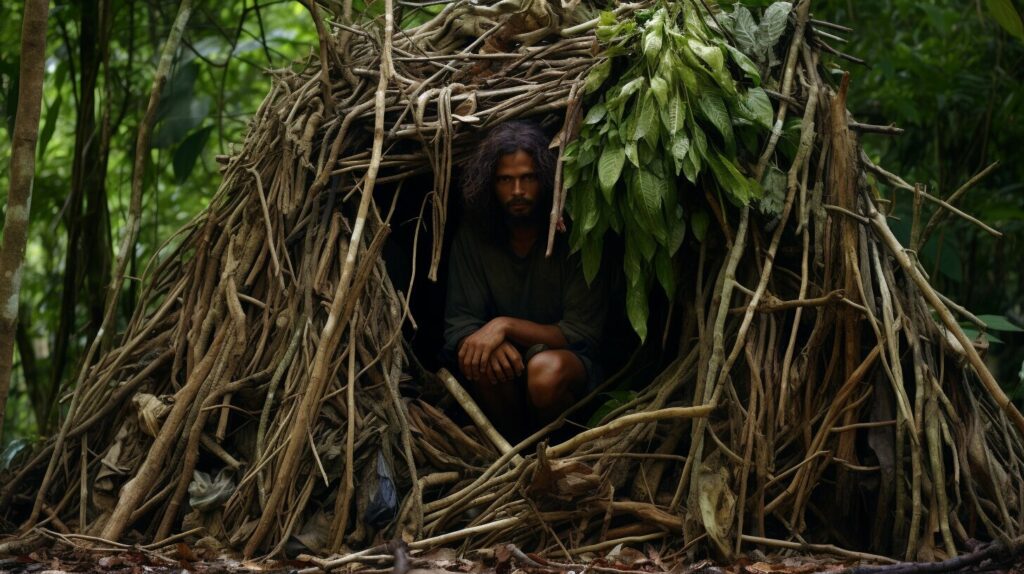
Conclusion
Surviving in the jungle is not an easy task, but with the right set of skills and knowledge, you can stay safe and thrive in this challenging environment.
In this guide, we have discussed the importance of jungle survival and shared essential tips and techniques that can help you navigate the tropical wilderness. From assessing the jungle environment to building a shelter, finding water sources, and obtaining food, we have covered it all.
Remember, the key to surviving in the jungle is mental and emotional preparedness. This means staying positive, managing stress, and focusing on your survival goals. With the right mindset, you can overcome even the toughest challenges.
Start Preparing Now
Whether you’re planning to go on a jungle expedition or simply want to be prepared for the unexpected, mastering jungle survival skills is essential. By following the tips and techniques outlined in this guide, you can build the skills and confidence you need to thrive in the wild.
Remember to always stay alert and aware of your surroundings, and never underestimate the power of nature. With the right mindset and the right skills, you can overcome any obstacle and emerge victorious in the face of adversity.
So start preparing now, and embrace the adventure of jungle survival.
FAQ
What is jungle survival?
Jungle survival refers to the knowledge, skills, and techniques required to survive in the wild and challenging environment of the jungle. It involves understanding the unique characteristics of the jungle, assessing the environment, building shelters, finding and purifying water, mastering fire skills, navigating, obtaining food, providing first aid, and maintaining mental and emotional preparedness.
Why is it important to have jungle survival skills?
Having jungle survival skills is crucial because the jungle environment presents numerous challenges and hazards. Being prepared with essential tips and skills increases your chances of survival in the wilderness. It allows you to navigate the jungle safely, find water and food sources, build shelter, start a fire, provide basic first aid, and maintain a positive mindset in order to endure and overcome the difficulties you may face.
What are some key jungle survival techniques?
Some key jungle survival techniques include understanding the tropical wilderness, assessing the jungle environment, building a jungle shelter, finding and purifying water, mastering fire skills, navigating in the jungle, obtaining food, providing jungle first aid, and maintaining mental and emotional preparedness. These techniques equip you with the necessary knowledge and abilities to survive and thrive in the jungle.
How do you assess the jungle environment?
Assessing the jungle environment involves observing and understanding factors such as weather conditions, wildlife habitats, and the terrain. By being aware of these aspects, you can identify potential hazards and make informed decisions about your survival strategies. It is essential to know what resources are available and how they may impact your ability to find shelter, water, and food.
How do you build a jungle shelter?
Building a jungle shelter requires utilizing natural resources such as branches, leaves, and vines. By constructing a sturdy structure, you can protect yourself from the elements and wildlife. It is important to consider factors like location, size, insulation, and ventilation when building a shelter in the jungle.
How do you find and purify water in the jungle?
Finding water sources in the jungle can be challenging, but it is essential for survival. Look for signs such as animal tracks, vegetation, and topography that may indicate the presence of water. Once you find a water source, purify it by boiling, using water purification tablets, or constructing a simple filtration system. Purifying water removes harmful bacteria and viruses, making it safe to drink.
What are some fire-starting techniques for jungle survival?
Fire-starting techniques in the jungle include using friction-based methods like the bow drill or hand drill, using a fire plow, or utilizing a flint and steel tool. It is important to gather dry tinder, kindling, and fuel before attempting to start a fire. Fire provides warmth, protection, and the ability to cook food, making it a vital skill to master in jungle survival.
How do you navigate in the jungle?
Navigating in the dense jungle can be challenging due to the lack of clear landmarks. However, you can use natural features such as rivers, mountains, and distinctive trees as reference points. Additionally, learning basic orienteering skills, such as using a compass or the sun’s position, can help you maintain your sense of direction and find your way in the jungle.
What are some ways to obtain food in the jungle?
To obtain food in the jungle, you can employ various methods such as hunting for small game, fishing in rivers or streams, and gathering edible plants and fruits. It is crucial to familiarize yourself with the local flora and fauna, identifying which plants are safe to eat and which animals can be hunted for sustenance. Always prioritize safety and respect the environment while procuring food.
What are some essential first aid techniques for jungle survival?
Some essential first aid techniques for jungle survival include treating wounds, managing fractures or sprains, preventing infection, and addressing common jungle-related injuries such as insect bites or snake bites. It is important to carry a basic first aid kit and have knowledge of how to use its contents effectively in emergency situations. Prioritize safety and seek professional medical assistance whenever possible.
How can you maintain mental and emotional preparedness in the jungle?
Maintaining mental and emotional preparedness in the jungle involves developing resilience, managing stress, and staying focused on your survival goals. Strategies such as positive self-talk, mindfulness exercises, and maintaining a routine can help you stay mentally strong. Being aware of and acknowledging your emotions, while also practicing problem-solving and adapting to challenges, will contribute to your overall well-being in a jungle survival scenario.

